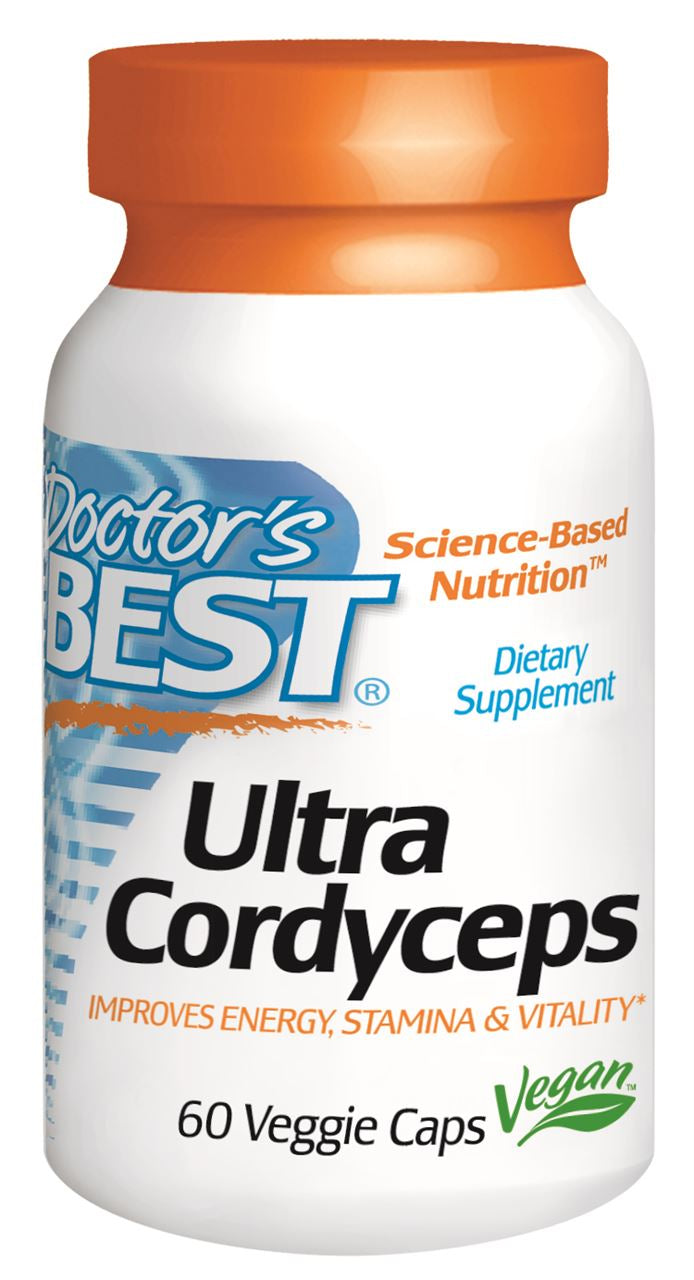Description
FEATURES AND BENEFITS
- Improves energy, stamina & vitality.
- Supports lung health.
- Supports liver function.
- Supports sexual health.
Doctor's Best Ultra Cordyceps contains pure cultivated Cordyceps sinensis, a herb used for centuries in China as a rejuvenating tonic that improves energy and supports function of various organs and systems.
The strain of Cordyceps in this product is recognised by the Chinese government as similar to wild Cordyceps sinensis, a rare fungus that grows above 15,000 feet in the Tibetan Highlands region of China.
Ingredients
| Active ingredients per capsule: | |
| Cordyceps sinensis (mycelium) | 750mg |
| supplying 8% cordycepic acid (60mg), 0.3 adesonine (2mg) |
Other ingredients: Modified cellulose (vegetarian capsule), cellulose, magnesium silicate.
Non-GMO and gluten free.
Contains nothing other than listed ingredients.
Directions
Adults: Take 1 to 4 capsules daily, with or without food.
Note: Cordyceps has mild blood-thinning properties. Use with caution when taking anti-coagulant (blod thinning) medications.
Benefits
The historical use of Cordyceps as an anti-aging herb in traditional Chinese practices dates back to 1700 BCE. During China’s Chin Dynasty, one emperor is said to have paid an ounce of gold for a three-day supply of the precious fungus. Tibetan scholars recorded detailed descriptions of Cordyceps in 15th and 18th century texts. Cordyceps was introduced to Europe at a scientific meeting in Paris in 1726, and was first imported to Japan in 1728.
Due to its wide range of biological actions, it has been used against fatigue, to escalate vitality and to promote longevity, and to support the health of the lungs, the kidneys, the liver, and the cardiovascular system.3,5Cordyceps is known as a “kidney tonic” in traditional Chinese practices, where the kidneys constitute a functional organ system that stores vital energy (or “Jing”). This is significant because under this tradition, Cordyceps is regarded as both “Yin-nourishing” and “Yang-invigorating” for a very balancing effect on many facets of human physiology, from sensitivity to cold to respiratory health.1 Science has confirmed the utility of Cordyceps for many purposes, including its anti-fatigue & anti-stress properties.6
Immune Response Support*
Results of many preclinical studies suggest that Cordyceps promotes balanced immune cell function. Among the most interesting of these studies was one that investigated the ability of Cordyceps to differentially modulate the activities of different dendrite cell stages—key to balancing control of the homeostatic steady-state of the our immune system. These results suggested that Cordyceps bolsters immune function where necessary, yet suppresses over-reactive immune responses.7 Other immune function results reported by Cordyceps researchers include elevation of natural killer cell activity, intestinal T-cell activation, and activation of signaling molecules that support the production of healthy immune proteins.8, 9
While scientists often strive to isolate individual compounds in a naturally occurring complex like Cordyceps to determine which is responsible for certain biological actions, this process can ignore the fact that different components in Cordyceps may have synergistic activity.2 One group of researchers found that when investigating the immune activity of different components of Cordyceps in mice, some polysaccharides could impact the phagocytic function of monocyte-macrophages, while others could enhance immune response differently. In more recent in vitro work, polysaccharide fraction from mycelia of Cordyceps not only promoted macrophage phagocytic function, but also stimulated macrophage nitric oxide production (another tool used by these immune cells to maintain health).10
Antiradical Properties*
In vitro studies have demonstrated that the polysaccharide content of Cordyceps is largely behind its free radical scavenging properties.11, 12 Although not yet clearly understood, the antiradical mechanism of polysaccharides could be the donation of hydrogen to break free radical chain reactions.13 Studies in rodents, in humans, and in the laboratory have demonstrated that Cordyceps can inhibit formation of MDA (malondialdehyde), a free radical byproduct, in the liver and possibly in the brain.3, 14 In mice, Cordyceps promoted cerebral antioxidant homeostasis and was shown to safeguarding the integrity of neuronal cells, which influenced neurobehavioral function.15 As in mice, cell membranes in the human brain are vulnerable to lipid peroxidation because of their high polyunsaturated fat content. Through animal and in vitro models of lipid peroxidation, Cordyceps has shown an ability to support the health and integrity of lipids in the face of free radical oxidation.3, 16
Scientific References
- Zhu, J.S., G.M. Halpern, and K. Jones, J Altern Complement Med, 1998. 4(3): p. 289-303.
- Zhou, X., et al., J Pharm Pharmacol, 2009. 61(3): p. 279-91.
- Paterson, R.R., Phytochemistry, 2008. 69(7): p. 1469-95.
- Baltasi, C., J Am Diet Assoc, 2007. 107(3): p. 432-3.
- Panda, A.K. and K.C. Swain, J Ayurveda Integr Med, 2011. 2(1): p. 9-13.
- Koh, J.H., et al., Biological & Pharmaceutical Bulletin, 2003. 26(5): p. 691-694.
- Li, C.Y., et al., J Leukoc Biol, 2009. 85(6): p. 987-95.
- Leu, S.F., et al., Biological & Pharmaceutical Bulletin, 2005. 28(9): p. 1722-1725.
- Koh, J.H., et al., Biosci Biotechnol Biochem, 2002. 66(2): p. 407-11.
- Chen, W., et al., Cell Immunol, 2010. 262(1): p. 69-74.
- Liu, Y.K. and W. Shen, World J Gastroenterol, 2003. 9(3): p. 529-33.
- Li, S.P., et al., Phytomedicine, 2001. 8(3): p. 207-12.
- Wang, B.J., et al., Food Chem Toxicol, 2005. 43(4): p. 543-52.
- Yamaguchi, Y., et al., Phytother Res, 2000. 14(8): p. 647-9.
- Liu, Z., et al., Behav Brain Funct, 2010. 6: p. 61.
- Yamaguchi, Y., et al., Phytother Res, 2000. 14(8): p. 650-2.
- Nakamura, K., et al., Jpn J Pharmacol, 1999. 79(4): p. 505-8.
- Manabe, N., et al., Br J Nutr, 2000. 83(2): p. 197-204.
- Gebhardt, R., Toxicol Appl Pharmacol, 1997. 144(2): p. 279-86.
- Li, H., et al., J Pharmacol Exp Ther, 2004. 310(3): p. 926-32.
- Zhou, W., et al., Cardiovasc Drug Rev, 2004. 22(4): p. 309-19.
- Mahadevan, S. and Y. Park, J Food Sci, 2008. 73(1): p. R14-9.
- Zhu, J.S., G.M. Halpern, and K. Jones, J Altern Complement Med, 1998. 4(4): p. 429-57.
- Blumenthal, M., et al., eds. 1998, American Botanical Council: Austin, TX. 683.

